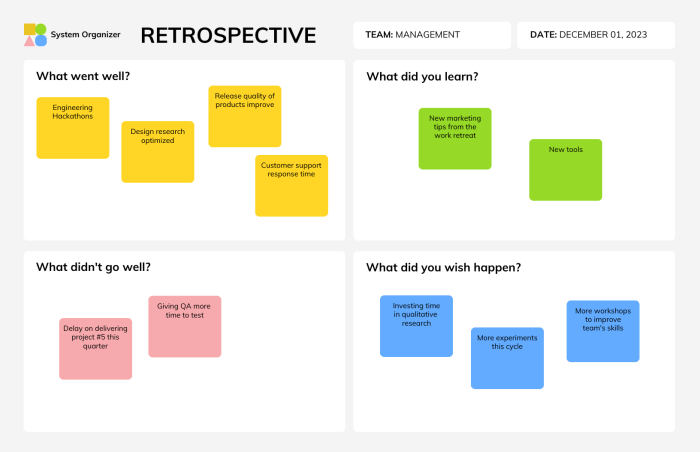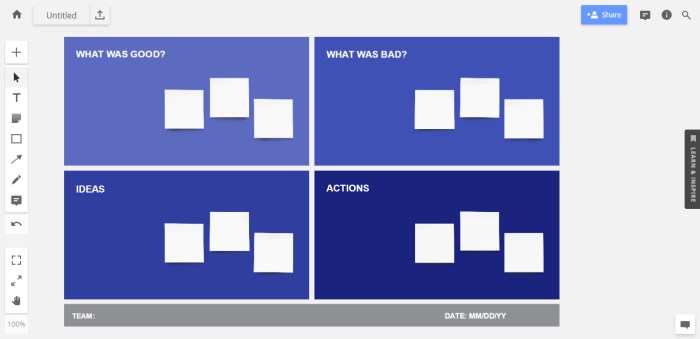Which are appropriate topics for discussion in a sprint retrospective – Sprint retrospectives offer a valuable opportunity to reflect on the previous sprint, identify areas for improvement, and enhance team performance. This article explores the appropriate topics for discussion during a sprint retrospective, providing guidance on how to conduct effective and productive meetings.
The key to a successful sprint retrospective lies in selecting topics that align with the sprint’s goals, the team’s performance, the sprint process, individual contributions, the product or service, and the team’s morale and motivation.
Topics related to the sprint’s goals and objectives
The sprint retrospective is an opportunity to reflect on the sprint’s goals and objectives and assess the extent to which they were met. The team should also identify any obstacles or challenges that prevented them from achieving their goals and suggest improvements to the goal-setting process or sprint planning process.
Goal Attainment, Which are appropriate topics for discussion in a sprint retrospective
- Evaluate the extent to which the sprint’s goals and objectives were met.
- Identify any factors that contributed to or hindered goal attainment.
Obstacles and Challenges
- Identify any obstacles or challenges that prevented the team from achieving their goals.
- Analyze the root causes of these obstacles and challenges.
- Suggest solutions to overcome these obstacles and challenges in future sprints.
Goal-Setting and Sprint Planning Improvements
- Suggest improvements to the goal-setting process to make it more effective.
- Suggest improvements to the sprint planning process to make it more efficient.
Topics related to the team’s performance: Which Are Appropriate Topics For Discussion In A Sprint Retrospective
The sprint retrospective is also an opportunity to assess the team’s overall performance during the sprint. The team should identify areas where they excelled and areas where they need to improve. They should also discuss ways to improve team communication, collaboration, and productivity.
Overall Performance Assessment
- Assess the team’s overall performance during the sprint.
- Identify areas where the team excelled and areas where they need to improve.
Communication and Collaboration
- Discuss ways to improve team communication.
- Discuss ways to improve team collaboration.
Productivity
- Discuss ways to improve team productivity.
- Identify any factors that are contributing to low productivity.
- Suggest solutions to overcome these factors and improve productivity.
Topics related to the sprint process

The sprint retrospective is also an opportunity to evaluate the effectiveness of the sprint process. The team should identify any areas where the process can be improved and suggest changes to make it more efficient and effective.
Process Evaluation
- Evaluate the effectiveness of the sprint process.
- Identify any areas where the process can be improved.
Process Improvements
- Suggest changes to the sprint process to make it more efficient.
- Suggest changes to the sprint process to make it more effective.
Topics related to individual performance

The sprint retrospective is also an opportunity to provide feedback on individual performance during the sprint. The team should identify areas where individuals can improve their performance and discuss ways to support individual growth and development.
Individual Performance Feedback
- Provide feedback on individual performance during the sprint.
- Identify areas where individuals can improve their performance.
Individual Growth and Development
- Discuss ways to support individual growth and development.
- Identify any resources or training that can help individuals improve their performance.
Topics related to the product or service

The sprint retrospective is also an opportunity to discuss the progress made on the product or service during the sprint. The team should identify any areas where the product or service can be improved and suggest new features or enhancements.
Product/Service Progress
- Discuss the progress made on the product or service during the sprint.
- Identify any areas where the product or service can be improved.
Product/Service Improvements
- Suggest new features or enhancements for the product or service.
- Prioritize these new features or enhancements based on their potential impact.
Topics related to the team’s morale and motivation
The sprint retrospective is also an opportunity to assess the team’s morale and motivation levels. The team should identify any factors that are contributing to low morale or motivation and suggest ways to improve team morale and motivation.
Morale and Motivation Assessment
- Assess the team’s morale and motivation levels.
- Identify any factors that are contributing to low morale or motivation.
Morale and Motivation Improvements
- Suggest ways to improve team morale and motivation.
- Identify any resources or activities that can help improve team morale and motivation.
FAQ
What is the primary purpose of a sprint retrospective?
The primary purpose of a sprint retrospective is to reflect on the previous sprint, identify areas for improvement, and enhance team performance.
Who should participate in a sprint retrospective?
All team members should participate in a sprint retrospective, including developers, testers, product owners, and stakeholders.
How often should sprint retrospectives be held?
Sprint retrospectives should be held at the end of each sprint, typically on a weekly or bi-weekly basis.